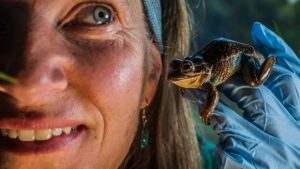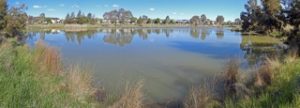What is FrogWATCH??

The ACT and Region FrogWatch program runs a lot of activities, all related to the wonderful world of frogs in our capital region. Frogwatch started in 2002 and has since continually grown into a fully-fledged citizen science and community oriented program.
Our main projects
- The annual FrogWatch Census is one of the few long-term data sets world-wide on the distribution and abundance of frogs in an urban and peri-urban environment. Volunteers engage as citizen scientists, and collect much needed data on our local frogs. Since 2019, the annual FrogCensus monitoring period has been extended from the annual water week to the entire months of October. This leaves more opportunity to embark on frog monitoring under favourable conditions (on mild nights after rain). Some projects require additional monitoring outside of this period, and many volunteers like to keep an eye on their patch all year round.
- Another really exciting frog monitoring activity has been our 2015-2018 Climate Change project, which looked at changes in frog behaviour due to a warming climate.
- In 2018 we ran in-depth frog habitat assessments and frog surveys at 45 ponds across the ACT in an extended version of the 2015 Bio-indicator study. Read more here.
- The FrogPhone development, an applied ecology development, is summarized in this paper.
- The Frogs For The Future education stream delivers a range of school education products, including school visits, frog tank loan, educational material and the Tadpole Kits for Schools Program (funded by Icon Water).
Why monitor frogs?

Frog species are indicators of environmental health and their presence can indicate good water quality and the availability of high quality habitat. The absence or decline of frog populations can indicate unhealthy or degraded catchments. They are useful as a monitoring focus for a number of reasons:
Frog eggs do not have a shell, and adult frogs have permeable skin to “drink” and breathe through. Therefore, frogs are sensitive to even small concentrations of pollutants such as pesticides, detergents and industrial chemicals in waterways, the soil or the air, as they easily penetrate into the frogs’ system.
Frogs require water to breed. Therefore frogs can only reproduce in a waterway that is relatively free of toxic pollutants.
Frogs have a distinctive mating call for every species that is relatively easy to learn and recognise. Therefore, frogs can be monitored in a non-invasive, inexpensive way.
Why monitor frogs? Frog species are indicators of environmental health and their presence can indicate good water quality and the availability of high quality habitat. The absence or decline of frog populations can indicate unhealthy or degraded catchments. They are useful as a monitoring focus for a number of reasons: Frog eggs do not have a shell, and adult frogs have permeable skin to “drink” and breathe through. Therefore, frogs are sensitive to even small concentrations of pollutants such as pesticides, detergents and industrial chemicals in waterways, the soil or the air, as they easily penetrate into the frogs’ system. Frogs require water to breed. Therefore frogs can only reproduce in a waterway that is relatively free of toxic pollutants. Frogs have a distinctive mating call for every species that is relatively easy to learn and recognise. Therefore, frogs can be monitored in a non-invasive, inexpensive way.
Would you like to join the Frogwatch team and get involved in its many projects?? Simply contact the Frogwatch Coordinator on 62783309, or send us an email to frogwatch@ginninderralandcare.org.au
